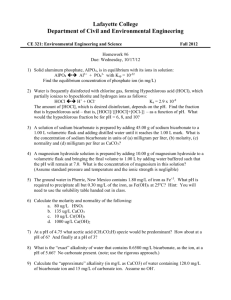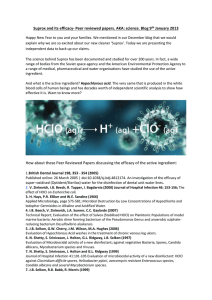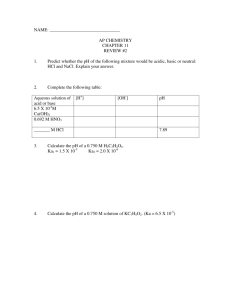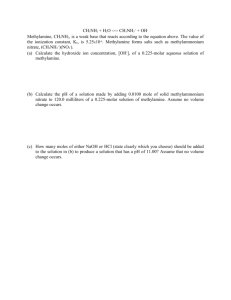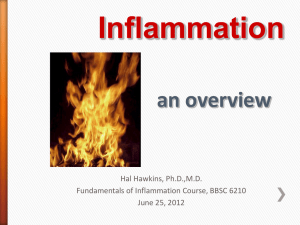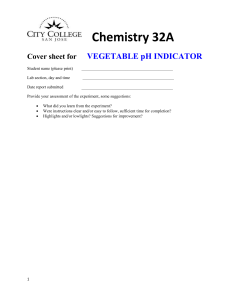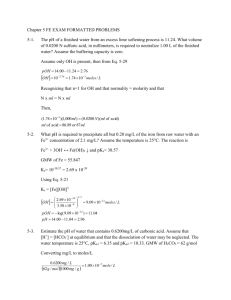DEPARTMENT OF CIVIL ENGINEERING
advertisement
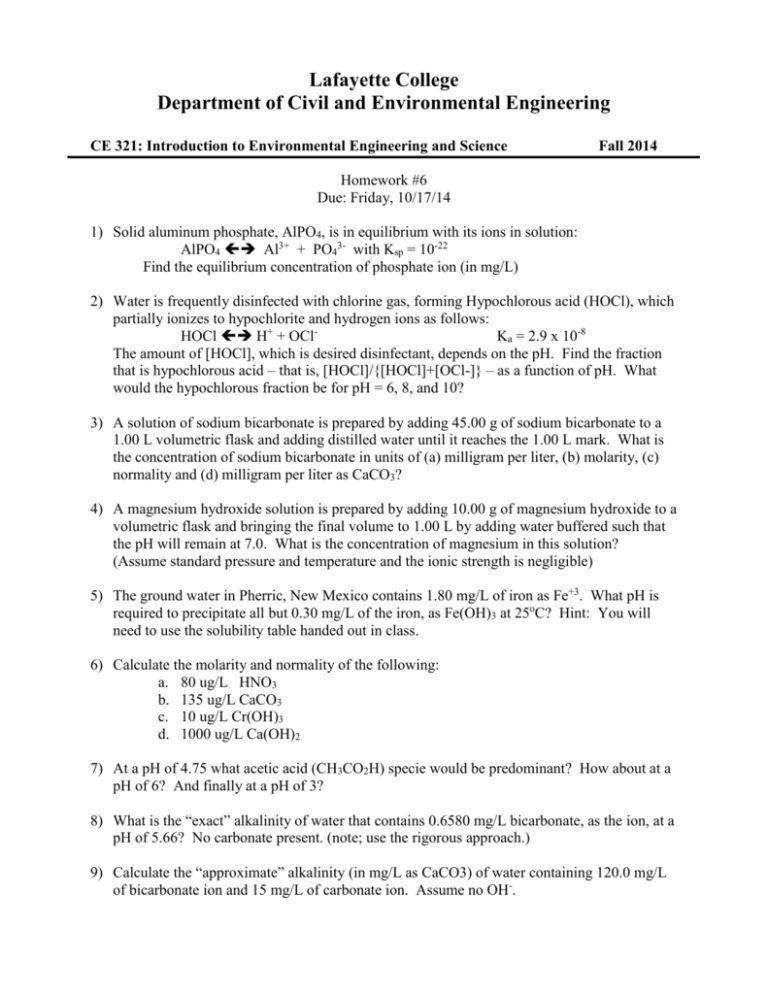
Lafayette College
Department of Civil and Environmental Engineering
CE 321: Introduction to Environmental Engineering and Science
Fall 2014
Homework #6
Due: Friday, 10/17/14
1) Solid aluminum phosphate, AlPO4, is in equilibrium with its ions in solution:
AlPO4 Al3+ + PO43- with Ksp = 10-22
Find the equilibrium concentration of phosphate ion (in mg/L)
2) Water is frequently disinfected with chlorine gas, forming Hypochlorous acid (HOCl), which
partially ionizes to hypochlorite and hydrogen ions as follows:
HOCl H+ + OClKa = 2.9 x 10-8
The amount of [HOCl], which is desired disinfectant, depends on the pH. Find the fraction
that is hypochlorous acid – that is, [HOCl]/{[HOCl]+[OCl-]} – as a function of pH. What
would the hypochlorous fraction be for pH = 6, 8, and 10?
3) A solution of sodium bicarbonate is prepared by adding 45.00 g of sodium bicarbonate to a
1.00 L volumetric flask and adding distilled water until it reaches the 1.00 L mark. What is
the concentration of sodium bicarbonate in units of (a) milligram per liter, (b) molarity, (c)
normality and (d) milligram per liter as CaCO3?
4) A magnesium hydroxide solution is prepared by adding 10.00 g of magnesium hydroxide to a
volumetric flask and bringing the final volume to 1.00 L by adding water buffered such that
the pH will remain at 7.0. What is the concentration of magnesium in this solution?
(Assume standard pressure and temperature and the ionic strength is negligible)
5) The ground water in Pherric, New Mexico contains 1.80 mg/L of iron as Fe+3. What pH is
required to precipitate all but 0.30 mg/L of the iron, as Fe(OH)3 at 25oC? Hint: You will
need to use the solubility table handed out in class.
6) Calculate the molarity and normality of the following:
a. 80 ug/L HNO3
b. 135 ug/L CaCO3
c. 10 ug/L Cr(OH)3
d. 1000 ug/L Ca(OH)2
7) At a pH of 4.75 what acetic acid (CH3CO2H) specie would be predominant? How about at a
pH of 6? And finally at a pH of 3?
8) What is the “exact” alkalinity of water that contains 0.6580 mg/L bicarbonate, as the ion, at a
pH of 5.66? No carbonate present. (note; use the rigorous approach.)
9) Calculate the “approximate” alkalinity (in mg/L as CaCO3) of water containing 120.0 mg/L
of bicarbonate ion and 15 mg/L of carbonate ion. Assume no OH-.
10) Convert the following from milligrams per liter as the ion or compound to milligrams per
liter as CaCO3.
a. 200.00 mg/L NH4+
b. 280.00 mg/L K+
c. 123.45 mg/L SO4-2
d. 85.05 mg/L Ca2+
e. 19.90 mg/L Na+
11) You are in an environmental engineering laboratory:
a. You have been asked to prepare a solution sodium hydroxide (NaOH). You add 5 grams
of pure NaOH pellets and then fill the beaker to 1.0 liter with deionized water. What is
the pH of the solution after equilibrium has been reached?
b. Now you are asked to predict the pH of distilled water after adding a specific amount of
acid. The type of acid used is sulfuric acid (H2SO4). Using a 0.1 M solution of H2SO4
and a 0.5 cubic centimeter syringe you are told to add 15 full injections to a beaker and
then fill the beaker to the 2 liter mark….what is the pH of the solution?
12) In the atmosphere, sulfur dioxide (released by coal-burning power plants) reacts relatively
slowly with oxygen and water vapor to form sulfuric acid, a pollutant that has the potential to
cause serve respiratory distress and acid rain.
SO2 + O2 + H2O H2SO4
a) Balance the above reaction
b) As done in class,
i) show the charges of element,
ii) show the elements that are oxidized and reduced
iii) calculate the number of electrons gain and lost.
Present information in a clear and concise fashion and SHOW ALL WORK
13) The following reaction is important in lake and river sediments that are devoid of oxygen.
SO42- + H+ + CH2O HS- + CO2 + H2O
a) Balance the above reaction
b) As done in class,
iv) show the charges of element,
v) show the elements that are oxidized and reduced
vi) calculate the number of electrons gain and lost.
Present information in a clear and concise fashion and SHOW ALL WORK
